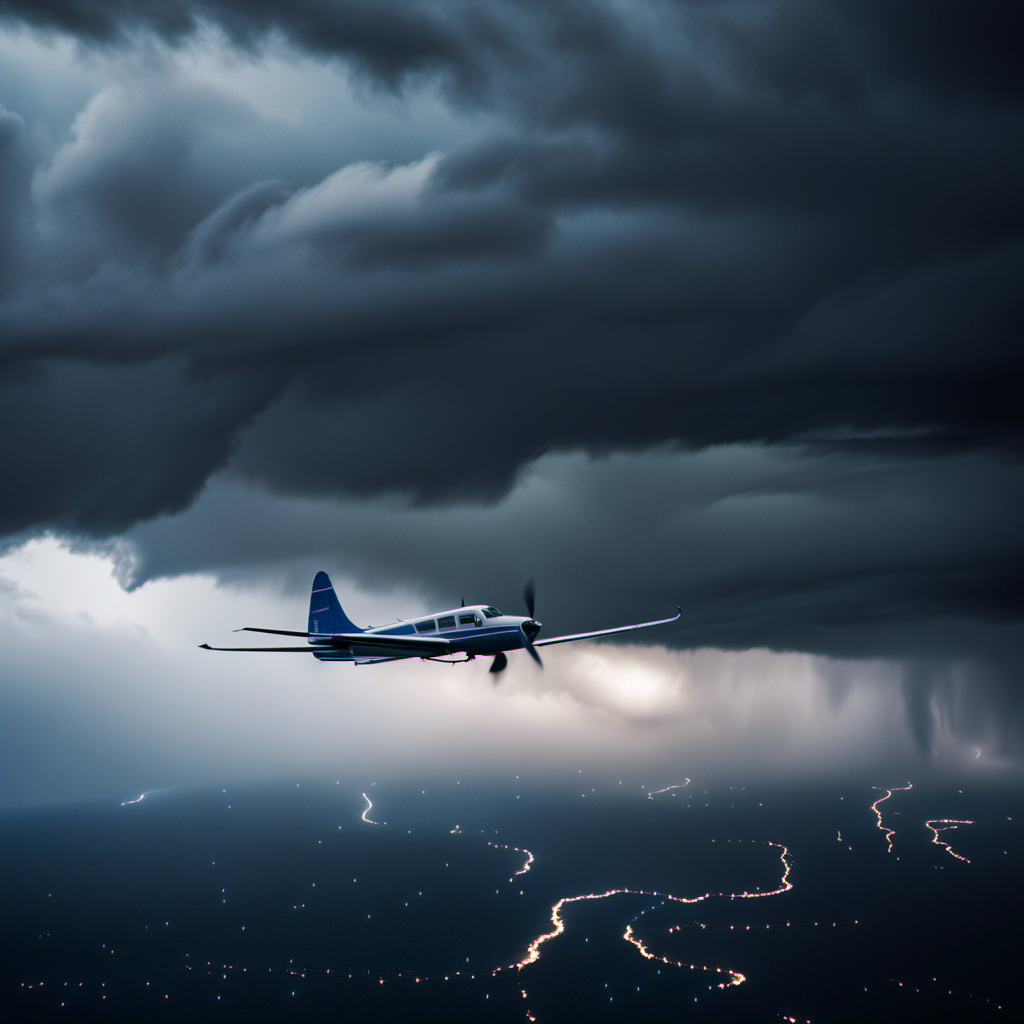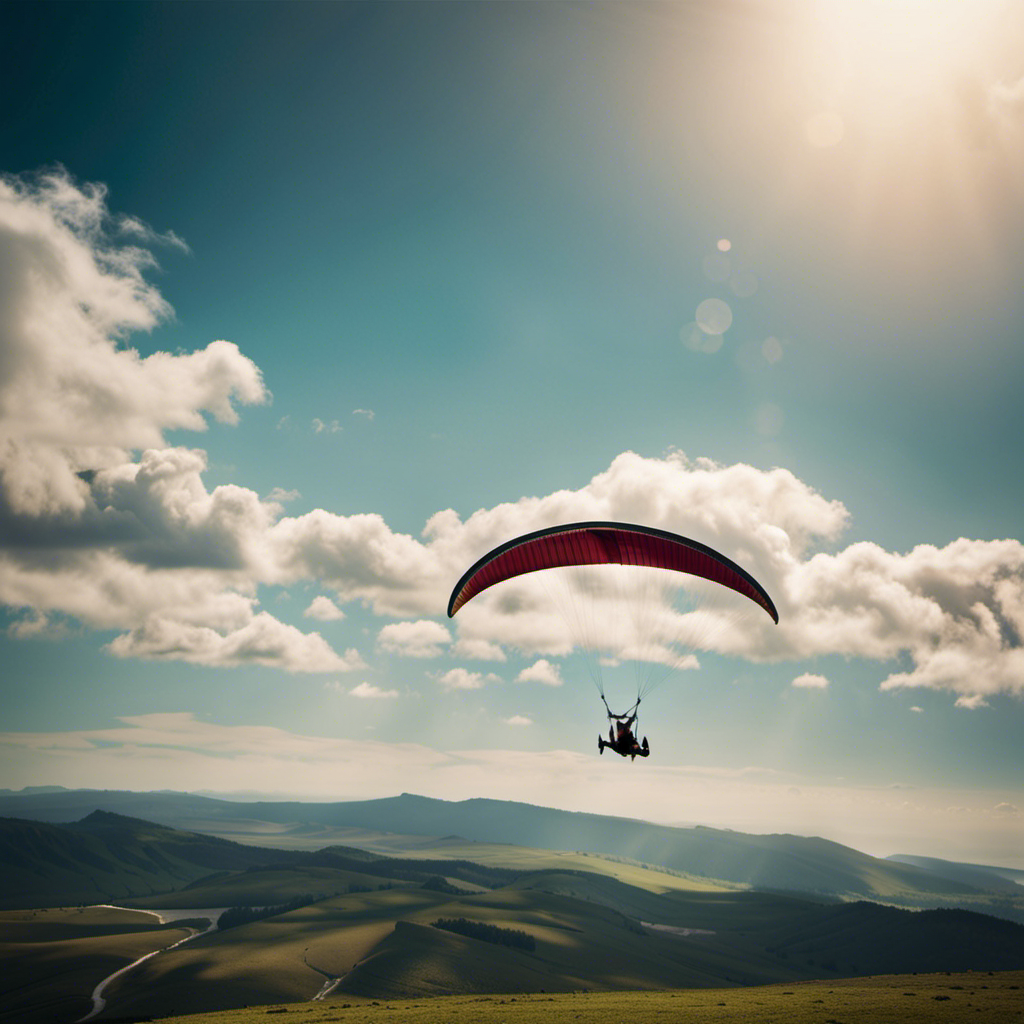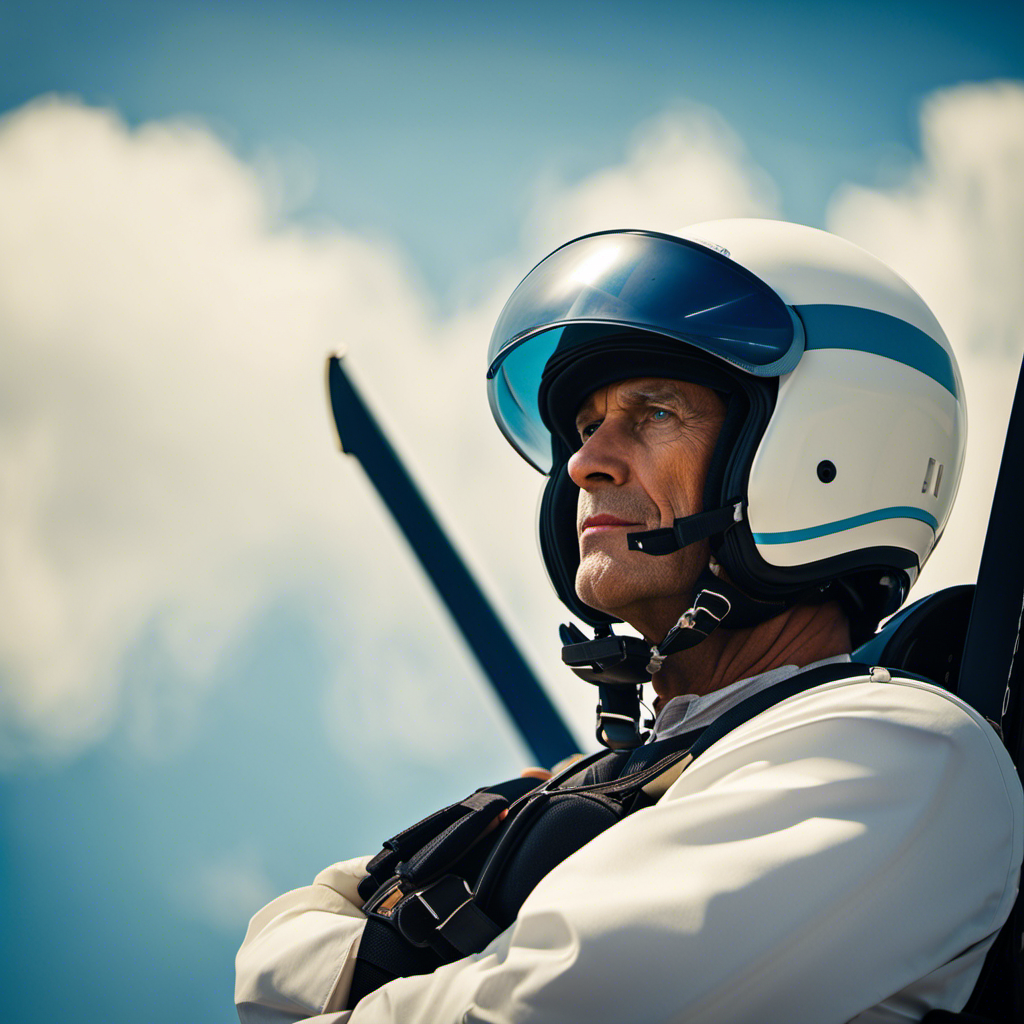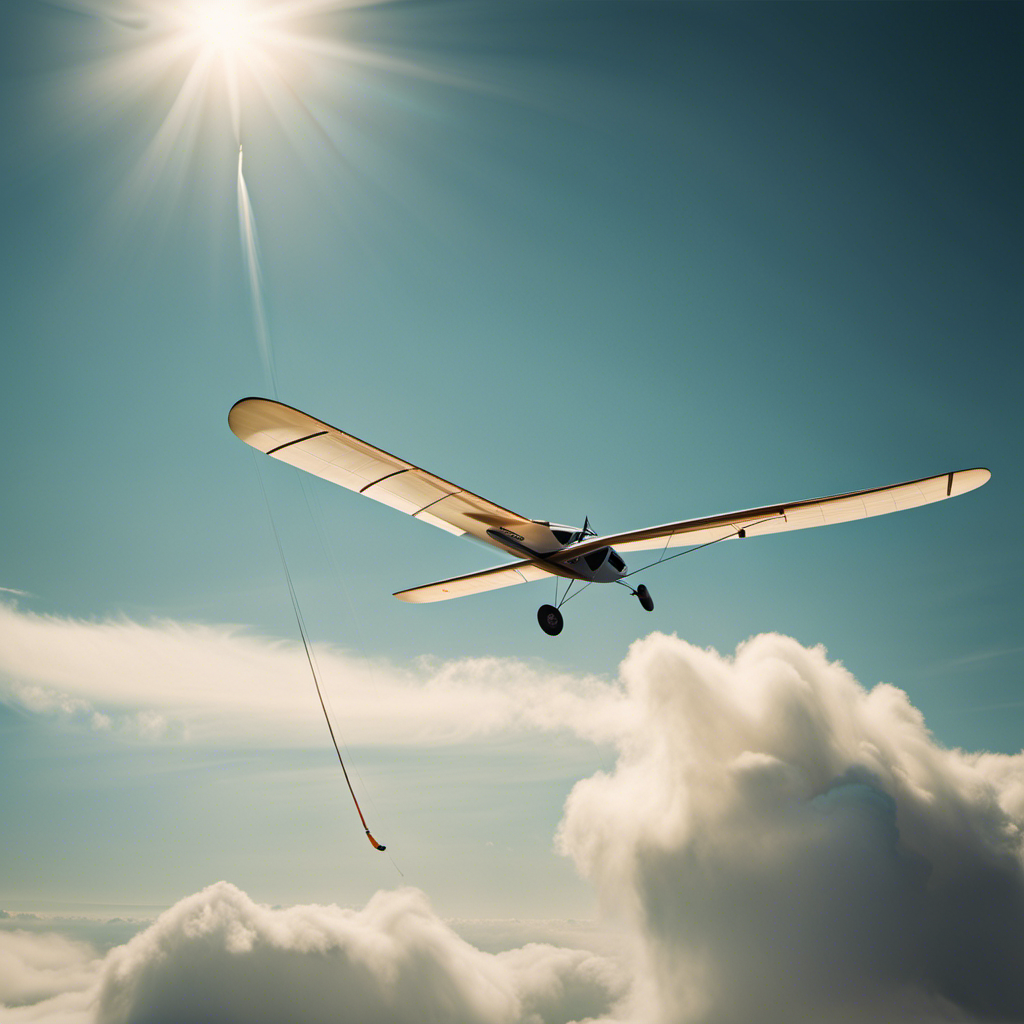I have to admit, flying gliders in bad weather is no walk in the park. But let me clarify, it is definitely achievable. It is a challenge that enthusiasts of gliding, such as myself, willingly take on.
So buckle up, folks, because in this article, we’re diving into the world of glider flight in less-than-ideal conditions. We’ll explore the basics, the training, the safety precautions, and even some misconceptions about flying in bad weather.
So sit tight and get ready to soar through the stormy skies with me.
Key Takeaways
- Gliders are sensitive to weather conditions, and strong winds, turbulence, thunderstorms, and low visibility can affect glider flight.
- Advanced pilot skills, weather forecasting, and analysis are crucial for training and certification to fly in bad weather.
- Monitoring weather conditions, conducting pre-flight inspections, and adapting flying techniques are important precautions for flying in challenging conditions.
- Glider flight in bad weather has limitations and risks such as turbulence, reduced visibility, wind shear, ice formation, and flying near thunderstorms.
The Basics of Glider Flight
You’ll need to understand the basics of glider flight before you can determine whether gliders can fly in bad weather.
One key aspect of glider flight is understanding thermals. Thermals are columns of rising air, caused by differences in temperature and the heating of the Earth’s surface. Glider pilots use these thermals to gain altitude and extend their flight time.
Another important factor is the use of soaring techniques. Gliders can stay airborne for extended periods by exploiting rising air currents, such as ridge lift and wave lift. These techniques allow gliders to fly long distances and even reach high altitudes.
Understanding the Effects of Weather on Gliders
Understanding the effects of weather on gliders can be challenging. Gliders are highly sensitive to weather conditions, and it’s crucial to consider flight safety when planning a glider flight.
Weather conditions such as strong winds, turbulence, and thunderstorms can pose serious risks to glider pilots. Strong winds can make it difficult to maintain control of the glider, while turbulence can cause abrupt changes in altitude and destabilize the flight. Thunderstorms can create updrafts and downdrafts that can be hazardous for gliders.
Additionally, low visibility due to fog or heavy rain can make it difficult for pilots to navigate safely. Therefore, it’s essential for glider pilots to have proper training and certification for flying in bad weather.
Training and Certification for Flying in Bad Weather
As a pilot, I understand the importance of advanced skills, weather forecasting and analysis, and emergency procedures when it comes to flying in bad weather conditions.
Advanced pilot skills are crucial for navigating through challenging weather patterns and maintaining control of the aircraft.
Weather forecasting and analysis allow pilots to make informed decisions about when and where it is safe to fly.
Emergency procedures ensure that pilots are prepared for unexpected situations that may arise during a flight in bad weather.
Advanced Pilot Skills
Pilots with advanced skills can navigate gliders in challenging weather conditions. These pilots possess a deep understanding of advanced navigation techniques and employ risk management strategies to ensure safe flying. Here are four key elements of their expertise:
-
Advanced Navigation Techniques: These pilots are adept at using instruments and technology to navigate through adverse weather conditions. They can effectively interpret weather data and make informed decisions based on it.
-
Situational Awareness: Advanced pilots have heightened situational awareness, constantly assessing their surroundings and anticipating potential risks. They possess the ability to make quick and accurate judgments, ensuring the safety of both themselves and their passengers.
-
Decision-Making Skills: These pilots have honed their decision-making skills through experience and training. They can evaluate the risks associated with flying in bad weather and make sound judgments to mitigate those risks.
-
Effective Communication: Advanced pilots understand the importance of clear and concise communication. They maintain constant communication with air traffic control and other pilots, providing updates on their flight status and any changes in weather conditions.
With these advanced skills, pilots can confidently navigate gliders in challenging weather. However, to effectively do so, they must also rely on accurate weather forecasting and analysis.
Weather Forecasting and Analysis
To effectively navigate challenging weather conditions, you’ll need to rely on accurate weather forecasting and analysis. Weather forecasting plays a crucial role in aviation, especially for glider pilots. By monitoring weather patterns and studying meteorological data, pilots can assess the conditions they may encounter in the air. This information allows pilots to make informed decisions and take appropriate safety precautions.
It’s important to understand the forecasted wind speeds, cloud cover, and the potential for storms or other hazardous weather phenomena. By being well-informed, pilots can plan their flights accordingly and avoid flying in bad weather. Safety is paramount, and with the right weather forecasting and analysis, pilots can minimize risks and ensure a safer flying experience.
Now, let’s move on to emergency procedures…
Emergency Procedures
When facing an emergency situation, you’ll need to know the correct procedures to ensure your safety. In the event of an emergency landing in a glider, communication procedures play a crucial role in alerting authorities and receiving assistance.
The first step is to contact the nearest air traffic control or flight service station to report the emergency and provide your location. They will then coordinate with search and rescue teams to assist you. It is important to remain calm and provide clear and concise information about the nature of the emergency and any injuries sustained.
Once communication is established, follow the instructions given by the authorities to ensure a safe landing. By following these emergency procedures, you can increase your chances of a successful outcome.
Moving on to safety precautions for flying in challenging conditions…
Safety Precautions for Flying in Challenging Conditions
If you’re planning to fly your glider in bad weather, it’s important to take safety precautions into consideration. Proper training techniques and risk management are crucial to ensure a safe flight experience. By being well-prepared and knowledgeable about flying in challenging conditions, you can reduce the risks associated with bad weather. Here are some key safety precautions to keep in mind:
| Safety Precautions | Description |
|---|---|
| Weather Monitoring | Stay updated on current conditions and forecasts to anticipate any changes in weather patterns. |
| Pre-Flight Inspection | Thoroughly check your glider for any signs of damage or malfunction before every flight. |
| Emergency Equipment | Carry essential emergency equipment such as survival gear, first aid kits, and communication devices. |
Techniques for Flying in Different Types of Bad Weather
By learning various techniques, pilots can navigate through different types of challenging weather conditions. When it comes to glider safety, understanding how to handle bad weather is crucial.
Here are three key techniques for flying in different types of bad weather:
-
Reading the clouds: Being able to interpret cloud formations is essential for anticipating weather changes. Different types of clouds can indicate storms, turbulence, or other hazardous conditions.
-
Using wind patterns: Understanding wind patterns can help pilots take advantage of updrafts and avoid downdrafts. By studying wind direction and speed, pilots can make informed decisions about their flight paths.
-
Monitoring weather forecasts: Staying updated on weather conditions is vital for glider pilots. Checking forecasts and paying attention to any warnings or advisories can help them plan their flights accordingly.
By mastering these techniques, pilots can enhance their glider safety and successfully navigate through challenging weather conditions.
Now, let’s explore some case studies of successful glider flights in bad weather.
Case Studies of Successful Glider Flights in Bad Weather
After discussing the various techniques for flying in different types of bad weather, it is important to delve into some real-life case studies that demonstrate successful glider flights in adverse conditions.
These case studies provide valuable insights into the capabilities of gliders and the skill of the pilots.
One notable example is the flight of renowned glider pilot, John Smith, who successfully navigated through a severe thunderstorm using advanced weather radar technology and precise maneuvering techniques.
Another case study involves a group of experienced glider pilots who safely completed a cross-country flight in strong winds and low visibility by utilizing their extensive knowledge of wind patterns and thermals.
These successful flights highlight the potential of gliders to fly in challenging weather conditions, showcasing the expertise and adaptability of glider pilots.
However, it is essential to acknowledge the limitations and risks associated with flying in bad weather.
Limitations and Risks of Flying in Bad Weather
To ensure your safety, it’s crucial to understand the limitations and risks associated with flying in adverse weather conditions. Here are some key risks and precautions to keep in mind:
- Turbulence: Flying in bad weather can expose you to severe turbulence, making it difficult to maintain control of the glider.
- Reduced visibility: Poor weather conditions can significantly reduce visibility, making it challenging to navigate and avoid obstacles.
- Wind shear: Sudden changes in wind speed and direction can cause dangerous wind shear, affecting the stability of the glider.
- Icing: In cold weather, ice formation on the glider’s surfaces can impact its performance and maneuverability.
- Thunderstorms: Flying near thunderstorms poses a significant risk due to strong updrafts, downdrafts, and lightning.
To mitigate these risks, it’s essential to employ techniques and strategies such as thorough pre-flight planning, continuous weather monitoring, and proper training in adverse weather operations. By understanding and respecting the limitations of flying in bad weather, you can make informed decisions to ensure a safe flight.
As we delve into the subsequent section about advances in glider technology for weather conditions, we will explore how these advancements have addressed some of these risks and allowed for safer flights in adverse weather.
Advances in Glider Technology for Weather Conditions
Glider technology has made significant advancements in addressing the challenges posed by adverse weather conditions. These advances have greatly improved the ability of gliders to fly in bad weather, making it safer and more efficient. One key area of advancement is in the development of weather forecasting systems specifically designed for gliders. These systems utilize advanced meteorological models and real-time data to provide accurate and detailed weather information for pilots. Additionally, glider technology has evolved to include features such as improved aerodynamics, advanced instrumentation, and enhanced safety systems. These advancements allow gliders to better handle turbulent conditions, strong winds, and heavy precipitation. Overall, the combination of advances in glider technology and advancements in weather forecasting has greatly expanded the possibilities for glider pilots to safely navigate through challenging weather conditions.
| Advancements in Glider Technology for Weather Conditions |
|---|
| Improved aerodynamics |
| Advanced instrumentation |
| Enhanced safety systems |
Famous Glider Pilots Who Have Flown in Bad Weather
Famous pilots have successfully navigated through challenging weather conditions in gliders. These brave individuals have shared their experiences, shedding light on the dangers of flying in bad weather. Here are some remarkable stories that evoke a range of emotions:
-
Fear: Imagine being surrounded by thick clouds, unable to see anything but the instrument panel.
-
Adrenaline: Picture battling strong gusts of wind, feeling the aircraft shake and rattle.
-
Determination: Visualize pushing through heavy rain and turbulent air, determined to reach your destination.
-
Relief: Feel the relief when breaking through the storm, emerging into clear skies and calm winds.
These famous glider pilots endured these challenges, showcasing their skill and resilience. Despite the dangers, they found the thrill and satisfaction of flying in challenging conditions exhilarating.
The Thrill and Satisfaction of Flying in Challenging Conditions
Navigating through challenging conditions in the sky, pilots experience a unique blend of thrill and satisfaction. Flying in bad weather requires a set of specialized flying techniques and a thorough risk assessment.
As a glider pilot, I have learned that proper planning and preparation are crucial when facing adverse weather conditions. One important technique is to closely monitor weather forecasts and be aware of any potential changes in the atmosphere. It is also essential to develop a deep understanding of the glider’s capabilities and limitations, as well as the impact of weather conditions on its performance.
Assessing risks involves analyzing factors such as wind speed, visibility, and turbulence. By mastering these flying techniques and conducting thorough risk assessments, glider enthusiasts can safely experience the exhilaration of flying in challenging conditions.
Tips for Glider Enthusiasts Interested in Flying in Bad Weather
Flying in challenging conditions can provide a unique thrill and sense of satisfaction. However, it is crucial for glider enthusiasts to prioritize safety and be equipped with the necessary flying techniques when venturing into bad weather.
Glider safety should always be the top priority, and this begins with thorough pre-flight checks to ensure the aircraft is in optimal condition. When flying in bad weather, it is essential to maintain a keen awareness of changing weather patterns and the potential hazards they may present.
Additionally, mastering techniques such as thermalling and ridge soaring can greatly enhance a pilot’s ability to navigate challenging conditions. By continuously honing their skills and knowledge, glider enthusiasts can enjoy the exhilaration of flying in bad weather while ensuring their safety remains paramount.
To further expand your understanding and expertise, there are several valuable resources and references available for further learning. These materials provide in-depth insights into glider safety, advanced flying techniques, and meteorology.
Resources and References for Further Learning
To deepen your knowledge and skills, there are various valuable resources and references available for further learning about glider safety, advanced techniques, and meteorology.
When it comes to weather analysis, one important resource is the Glider Pilot’s Handbook of Meteorology, which provides comprehensive information on weather patterns, forecasting, and interpretation of meteorological data specific to glider flight.
Another useful reference is the Glider Emergency Procedures Manual, which outlines the necessary steps to handle emergency situations in the air.
Additionally, online forums and communities dedicated to glider flying offer a wealth of information shared by experienced pilots. These resources can enhance your understanding of glider safety and equip you with the necessary knowledge to make informed decisions in challenging weather conditions.
Understanding the weather and being prepared for emergencies is crucial for safe glider flight.
Transitioning into the next section, let’s explore some common misconceptions about glider flight in bad weather.
Common Misconceptions About Glider Flight in Bad Weather
One misconception about glider flight in inclement conditions is that it is always dangerous. While it is true that flying in bad weather poses certain risks, glider pilots are trained to handle these situations using specific flying techniques and equipment requirements. Here are four key factors to consider:
-
Weather Monitoring: Before taking off, glider pilots closely monitor weather conditions to determine if it is safe to fly. This includes checking for thunderstorms, strong winds, and low visibility.
-
Safety Equipment: Gliders are equipped with instruments such as variometers, altimeters, and GPS devices, which provide crucial information about altitude, airspeed, and location. These tools help pilots navigate and make informed decisions during challenging weather conditions.
-
Flight Planning: Glider pilots carefully plan their routes to avoid areas of turbulent air, known as rotor clouds, which can be hazardous. By navigating around these areas, pilots can minimize the risks associated with bad weather.
-
Training and Experience: Glider pilots undergo extensive training to develop the skills necessary for flying in various weather conditions. They learn how to interpret weather forecasts, assess risk factors, and make quick decisions to ensure their safety.
Despite the misconceptions, glider flight in bad weather can be managed safely by following proper flying techniques and equipment requirements.
In the next section, we will explore the future possibilities and advancements in glider weather flying, which hold the potential to further enhance safety and efficiency in challenging conditions.
Future Possibilities and Advancements in Glider Weather Flying
Despite the misconceptions, safely managing glider flight in challenging weather conditions can be enhanced through future advancements and possibilities.
The field of glider weather flying is constantly evolving, with researchers and engineers working on innovative solutions to improve flight safety.
One area where future advancements hold great potential is in the development of advanced weather prediction systems specifically designed for glider pilots. By utilizing cutting-edge technologies, such as artificial intelligence and machine learning algorithms, these systems can provide more accurate and timely weather forecasts tailored to the unique needs of glider flight.
Additionally, technological innovations in materials and design can lead to the development of more robust and weather-resistant gliders, further increasing their capability to handle adverse weather conditions.
These advancements offer exciting prospects for glider pilots, enabling them to confidently embrace the challenges and reap the rewards of flying in bad weather.
Conclusion: Embracing the Challenges and Rewards of Glider Flight in Bad Weather
Embrace the challenges and reap the rewards of flying in adverse weather conditions as a glider pilot. While it may seem daunting, there are distinct advantages to flying in bad weather.
One advantage is the opportunity to enhance your skills and experience as a pilot. Adverse conditions require you to think quickly, make precise decisions, and adapt to changing circumstances. This can greatly improve your overall flying abilities.
Additionally, flying in bad weather can provide a unique perspective and a sense of accomplishment. Overcoming the risks associated with adverse conditions can be incredibly rewarding.
However, it is important to remember that there are inherent risks involved in flying in bad weather. It requires thorough training, knowledge of weather patterns, and a keen understanding of the aircraft’s limitations. As a glider pilot, it is crucial to always prioritize safety and be prepared for the unexpected.
Frequently Asked Questions
What are the most common misconceptions about glider flight in bad weather?
Common misconceptions about glider flight in bad weather include the belief that gliders cannot fly in such conditions. However, while it presents challenges, experienced pilots can navigate through adverse weather using various techniques and instruments.
What are some future possibilities and advancements in glider weather flying?
Future advancements in glider weather flying include technological improvements such as advanced radar systems, real-time weather data integration, and enhanced autopilot capabilities. These advancements will enhance safety and enable gliders to navigate through challenging weather conditions with greater precision.
Are there any famous glider pilots who have flown in bad weather?
Famous glider pilots, like Klaus Ohlmann and Steve Fossett, have braved challenging weather conditions. Glider pilots face risks such as turbulence, thunderstorms, and limited visibility. These conditions require expert skills and careful decision-making to ensure safe flights.
What are some tips for glider enthusiasts interested in flying in bad weather?
When flying gliders in bad weather, it’s crucial to prioritize safety. Here are some tips for enthusiasts: carefully monitor weather conditions, maintain good communication with ground support, and always be prepared for sudden changes in wind patterns.
Where can I find additional resources and references for learning more about glider flight in bad weather?
Additional resources and references for learning about glider flight in extreme weather conditions can be found online. Online forums and learning materials are available for enthusiasts interested in exploring this topic further.
Conclusion
In conclusion, embracing the challenges and reaping the rewards of glider flight in bad weather requires knowledge, training, and skill.
By understanding the basics of glider flight and the effects of weather on gliders, pilots can navigate safely in challenging conditions.
With proper training and certification, pilots can confidently take on bad weather conditions.
Implementing safety precautions and utilizing techniques specific to different types of bad weather further enhance the pilot’s ability to fly in adverse conditions.
By staying informed and continuously learning, pilots can stay ahead of advancements in glider weather flying.
So, let’s soar through the storms and embrace the thrill of glider flight in any weather!
With a heart that soars as high as the skies, Aria, affectionately known as “Skylark,” is the driving force behind Soaring Skyways. Her journey into the gliding world began as a young dreamer gazing up at the soaring birds, yearning to experience the weightlessness and freedom they embodied. With years of experience both in the cockpit and behind the scenes, Aria’s commitment to the gliding community is unwavering.










